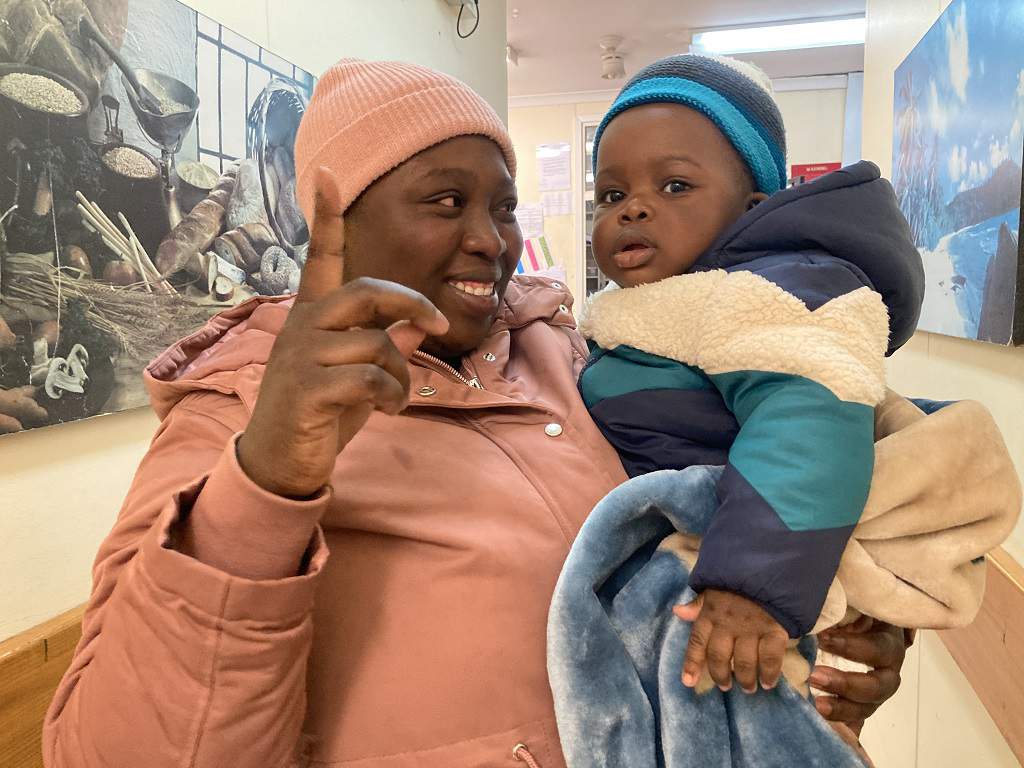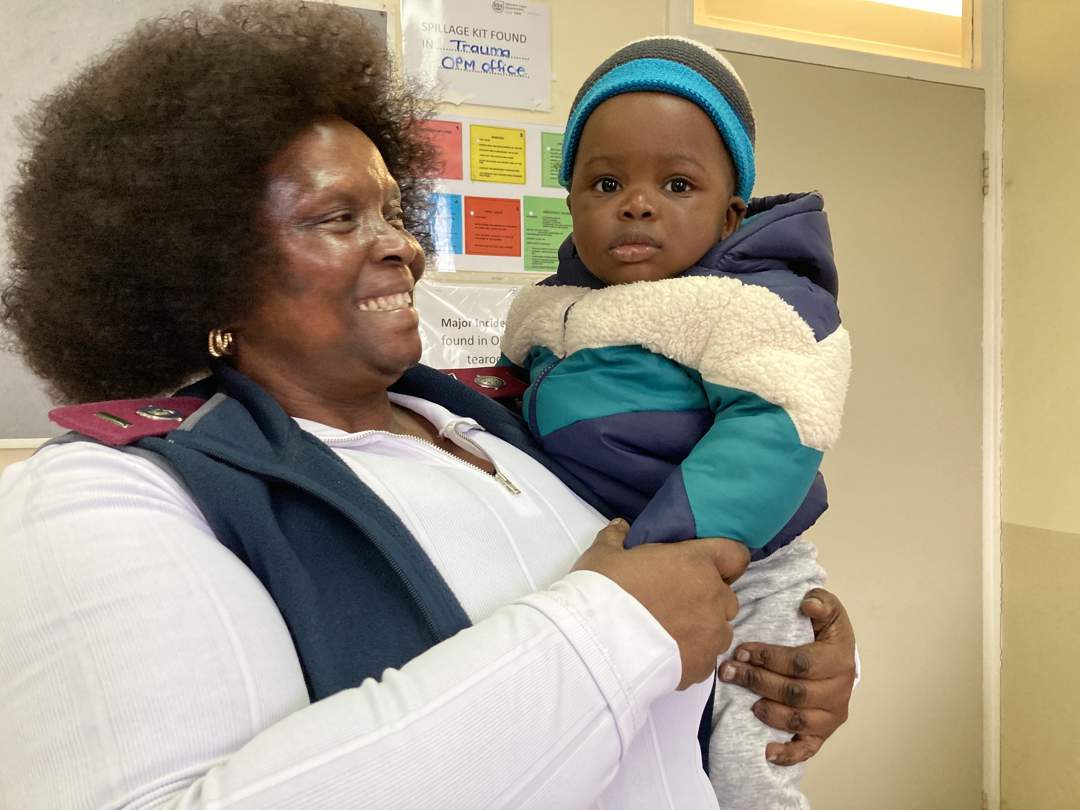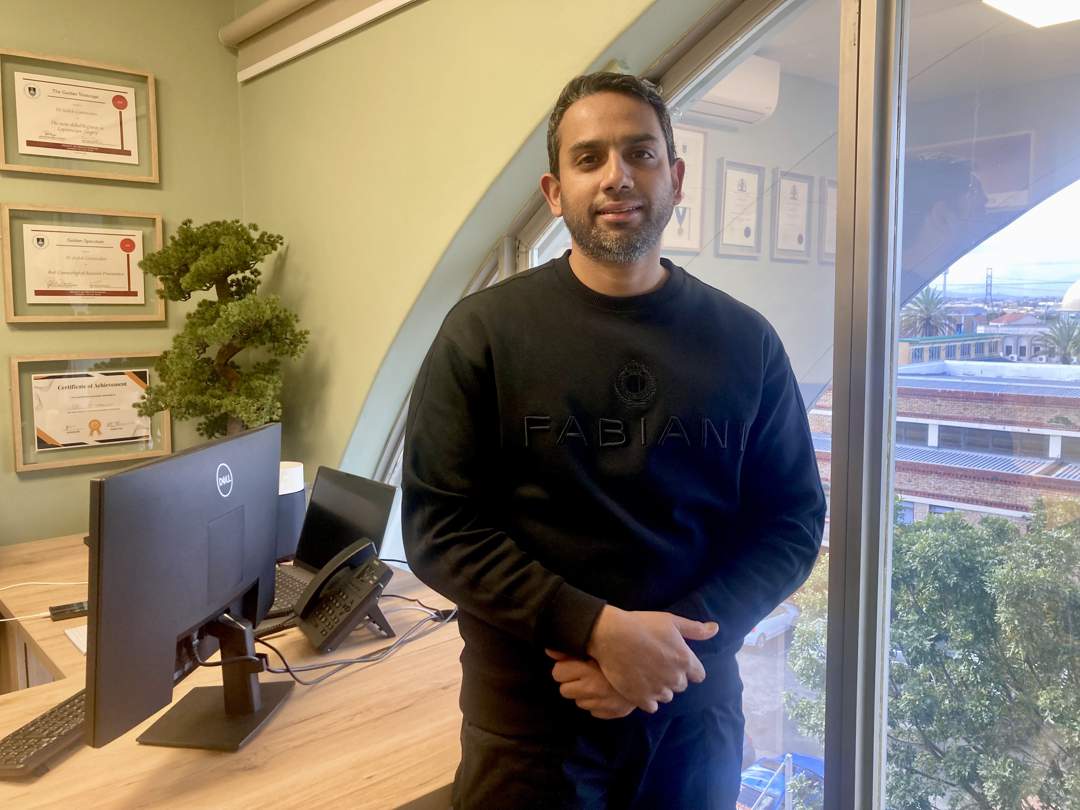
Sylvia Nodela and her son Joshua at the Gugulethu Community Health Clinic.
Biénne Huisman/Spotlight
Sylvia Nodela gave birth to a healthy baby who had grown to full term inside her pelvic cavity,outside her uterus. This was thanks to quick healthcare escalation and careful surgery by a multi-disciplinary team at Groote Schuur Hospital.Spotlight meets up with the mother and baby,and speaks to some of the healthcare professionals involved in the remarkable outcome.Sylvia Nodela’s eyes fill with tears as her son bounces in her arms,happily chirping. It’s a grey winter morning as we gather at a maternity clinic in Gugulethu. Exactly one year prior to our interview,Joshua’s birth defied formidable survival odds for both mother and baby – and yet here they are,both in excellent health.
At nine months pregnant,Nodela received devastating news. She reaches for tissue paper to wipe her cheeks as she recalls the heart-stopping moments on 30 July 2024,following an ultrasound at Cape Town’s Mowbray Maternity Hospital.
“I was told that they see the child,that they see the womb and that they see the placenta. But they said the baby is not inside the womb,that he’s outside the womb,” she says.
The 37-year-old continues: “So,they said they would have to do an operation the next day. I was told that there is a possibility we’re not going to survive. They said this operation is very huge.”
ADVERTISEMENT
In Cape Town’s medical circles,some experts comment on Nodela’s “miracle baby”,describing Joshua’s safe delivery as a remarkable public healthcare outcome and testimony to the city’s public obstetrics referral system.
WATCH | Old equipment,cramped spaces: Groote Schuur needs R100m to open new centre
Thanks to quick healthcare escalation and careful surgery by a multi-disciplinary team at Groote Schuur Hospital,affiliated to the University of Cape Town (UCT),Nodela gave birth to a healthy baby who had grown to full term inside her pelvic cavity,outside her uterus.
“It’s a great feeling. It’s a good story worth telling,” says Professor Mushi Matjila,who heads the Department of Obstetrics and Gynaecology at UCT.
ADVERTISEMENT
Advanced abdominal pregnancy occurs in about one in 10 000 to 30 000 pregnancies,and the condition poses a significant risk to mum and baby,Matjila says. In fact,early diagnosis in high-income countries usually results in termination. This is due to the “minimal likelihood of delivering a healthy baby and the risk of maternal complications,” he says.
Published data on incidence and outcomes,particularly in low- and middle-income countries,are scarce,mostly derived from isolated case reports. Matjila says it is not unusual for the diagnosis to be missed in low- and middle-income countries due to resource constraints.
A foetus outside the womb is at risk of getting hurt due to a lack of protection,Matjila explains. “There is a lack of fluid around the baby,because there isn’t a uterus. So,although the baby is in a sac,it does not grow as well as it should. Most of these babies are what we call growth-restricted. And [the foetus] may get compression effects because there isn’t enough cushioning to protect them against shocks,” he says.
ADVERTISEMENT
Speaking to Spotlight at the clinic in Gugulethu,Venfolo recalls: “I picked up that it was a breech. Normally by the last weeks of pregnancy,babies flip so their head points down toward the birth canal. In a breech position,the baby’s feet are pointing down instead of the head. I did not pick up that he was outside the uterus.”

Sister Olga Venfolo and Joshua.
Biénne Huisman/Spotlight
Venfolo referred Nodela to Mowbray Maternity Hospital and here,five days later,on July 30,an ultrasound identified an advanced abdominal pregnancy. This prompted an emergency referral by ambulance to Groote Schuur Hospital,where Nodela was observed overnight as a surgical team was assembled.
This type of rapid referral – from Gugulethu MOU to Mowbray Maternity to Groote Schuur – doesn’t always occur in South Africa’s public healthcare system.
Saying that he reviewed his clinical notes before our interview,Camroodien recalls:
Obviously,when we hear advanced abdominal pregnancy,all the alarm bells go off.
He says besides the obstetric surgeon team,himself,a colorectal surgeon and a urologist were asked to be on standby. “The reason being that we just didn’t know where the placenta had attached. It could have grown into the bladder,it could have grown into the bowel,it could have grown into the liver.”

Gynaecological Oncologist Dr Sedick Camroodien.
Biénne Huisman/Spotlight
In advanced abdominal pregnancy,removing the placenta is a demanding and tense procedure. Burrowed into an organ or large blood vessel,separating it poses a high risk of catastrophic maternal bleeding.
ADVERTISEMENT
Camroodien explains: “So,once they opened the patient up,they delivered the baby. Getting the baby out was fine; they ruptured the sack and delivered him. But then I got called because the placenta had actually grown into the pelvic side,which is my subspecialty.”
He adds:
So it’s fascinating in her case,actually,the placenta got its blood supply from that region. And that’s what allowed the pregnancy to actually continue and flourish.
“It was attached to that strong blood supply. The placenta was going past the external iliac artery and vein,growing into the area below that,which is called the obturator basin. There are a lot of veins and stuff,and if there’s bleeding there,it’s really difficult to stop. So,I mean,if any complications happened there,the patient could bleed and she could lose a limb.”
Camroodien admits breaking a sweat as he entered the theatre that day: “Trust me,I was praying walking into theatre. I think the one thing that stands out for me as a gynae oncologist – I mean,after 16 years of studying to sub-specialise – is that the pelvis will always humble you. Every case you come across is sacred and special. But in this case,thankfully,I could get the placenta out within two hours. I mean,from start to finish,with no major blood loss. I was very happy.”
“He’s my miracle baby,I tell anyone who would listen,” she says. “I was very lucky. And they explained the procedure nicely,how they would do it.”
Nodela lives in Philippi and worked as a cleaner before falling pregnant with her third child. She has two daughters,aged 18 and 20.
It is not the first remarkable birth at Groote Schuur. More than 20 years ago,the hospital made headlines around the world for the safe birth of Nhlahla. She was also part of an advanced abdominal pregnancy. Gynaecological oncologist Dr Bruce Howard safely delivered her from behind her mother’s liver. In fact,Camroodien says that Howard had been one of his mentors during his studies.
“The organisation of the healthcare system is everything,” says Matjila. “Let alone other countries in sub-Saharan Africa,this system is an example to certain provinces in South Africa. Essentially allocating resources – ultrasounds,the availability of blood and blood products,and more – to mothers who really need it.”
At Gugulethu MOU,3.6 babies are born daily,on average over the past three years (live,still,and premature births included). At Mowbray Maternity Hospital the figure is 27.1; and at Groote Schuur Hospital 7.1. This is according to spokesperson for Western Cape Health and Wellness,Samantha Lee-Jacobs.
As our interview draws to a close at Gugulethu MOU,Nodela picks up Joshua in his fleece-lined little jacket. In her one hand,she is carrying a shopping bag of Huggies nappies.
Venfolo rises to resume her work. Retired two years ago,she continues at the clinic as a locum,examining up to 18 mothers a day,from 07:00. “The way I love my work,” she says. “And the younger nurses here,they say that I am their inspiration.”
This article was first published by Spotlight – health journalism in the public interest. Sign up to the Spotlight newsletter.


United News - unews.co.za